Source:- Google.com.pk
Landscape Painting Biography
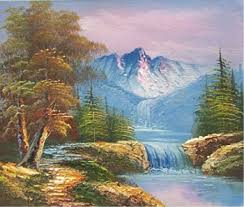
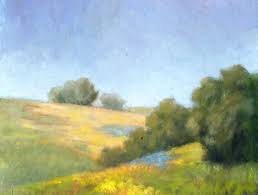

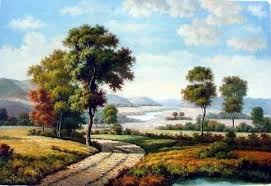
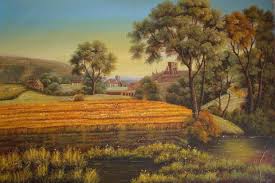
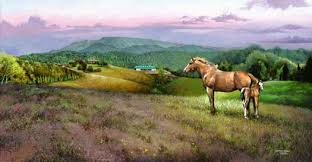

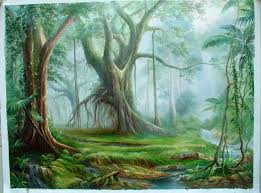
Landscape Painting Biography
The Voyage of Life series, painted by Thomas Cole in 1842, is a series of paintings that represent an allegory of the four stages of human life: childhood, youth, manhood, and old age. The paintings follow a voyager who travels in a boat on a river through the mid-19th century American wilderness. In each painting, accompanied by a guardian angel, the voyager rides the boat on the River of Life. The landscape, corresponding to the seasons of the year, plays a major role in telling the story. In each picture, the boat's direction of travel is reversed from the previous picture. In childhood, the infant glides from a dark cave into a rich, green landscape. As a youth, the boy takes control of the boat and aims for a shining castle in the sky. In manhood, the adult relies on prayer and religious faith to sustain him through rough waters and a threatening landscape. Finally, the man becomes old and the angel guides him to heaven across the waters of eternity.
Contents [hide]
1 Background
2 Childhood
3 Youth
4 Manhood
5 Old Age
6 Cultural significance
7 See also
8 Notes
9 Footnotes
10 References
11 External links
[edit]Background
Thomas Cole is regarded as the founder of the Hudson River School, an American art movement that flourished in the mid-19th century and was concerned with the realistic and detailed portrayal of nature but with a strong influence from Romanticism.[1] This group of American landscape painters worked between about 1825 and 1870 and shared a sense of national pride as well as an interest in celebrating the unique natural beauty found in the United States. The wild, untamed nature found in America was viewed as its special character; Europe had ancient ruins, but America had the uncharted wilderness. As Cole's friend William Cullen Bryant sermonized in verse, so Cole sermonized in paint. Both men saw nature as God's work and as a refuge from the ugly materialism of cities. Cole clearly intended the Voyage of Life to be a didactic, moralizing series of paintings using the landscape as an allegory for religious faith.
Unlike Cole’s first major series, The Course of Empire, which focused on the stages of civilization as a whole, the Voyage of Life series is a more personal, Christian allegory that interprets visually the journey of man through four stages of life: infancy, youth, manhood and old age. Done on commission, the finished works generated a disagreement with the owner about a public exhibition. In 1842 when Cole was in Rome he did a second set of the series which on his return to America was shown to acclaim. The first set is at the Munson-Williams-Proctor Arts Institute in Utica, New York, the second set is at the National Gallery of Art in Washington, D.C.
[edit]Childhood
The Voyage of Life Childhood
Artist Thomas Cole
Year 1842
Type Oil on canvas
Dimensions 133 cm × 198 cm (52 in × 78 in)
Location National Gallery of Art
In the first painting, Childhood, all the important story elements of the series are introduced: the voyager, the angel, the river, and the expressive landscape. An infant is safely ensconced in a boat guided by an angel. The landscape is lush; everything is calm and basking in warm sunshine, reflecting the innocence and joy of childhood. The boat glides out of a dark, craggy cave which Cole himself described as "emblematic of our earthly origin, and the mysterious Past."[1] The river is smooth and narrow, symbolizing the sheltered experience of childhood. The figurehead on the prow holds an hourglass representing time.
Detail of Thomas Cole's The Voyage of Life, Childhood: The boat, child, and angel on the water.
[edit]Youth
The Voyage of Life Youth
Artist Thomas Cole
Year 1842
Type Oil on canvas
Dimensions 134 cm × 194 cm (53 in × 76 in)
Location National Gallery of Art
The second painting, Youth, shows the same rich, green landscape, but here the view widens as does the voyager's experience. Now the youth grabs the tiller firmly as the angel watches and waves from the shore, allowing him to take control. The boy's enthusiasm and energy is evident in his forward-thrusting pose and billowing clothes. In the distance, a ghostly castle hovers in the sky, a white and shimmering beacon that represents the ambitions and dreams of man.
Detail of Thomas Cole's Voyage of Life, Youth: shows the boy departing in the boat, with the angel watching.
To the youth, the calm river seems to lead straight to the castle, but at the far right of the painting one can just glimpse the river as it becomes rough, choppy, and full of rocks. Cole comments on the landscape and the youth's ambitions: "The scenery of the picture--its clear stream, its lofty trees, its towering mountains, its unbounded distance, and transparent atmosphere--figure forth the romantic beauty of youthful imaginings, when the mind elevates the Mean and Common into the Magnificent, before experience teaches what is the Real."
This painting was used as the cover of the album Ancient Dreams by Swedish doom metal band Candlemass.[1]
[edit]Manhood
The Voyage of Life Manhood
Artist Thomas Cole
Year 1842
Type Oil on canvas
Dimensions 132.8 cm × 198.1 cm (52.3 in × 78.0 in)
Location National Gallery of Art
In the next painting, Manhood, the youth has grown into an adult and now faces the trials of life. The boat is damaged and the tiller is gone. The river has become a terrible rush of white water with menacing rocks, dangerous whirlpools, and surging currents. The warm sunlight of youth has been clouded over with dark and stormy skies and torrential rains. The trees have become wind-beaten, gnarled, leafless trunks. The fresh grass is gone, replaced by hard and unforgiving rock.
In the boat, the man no longer displays confidence or even control. The angel appears high in the sky, still watching over the man, who does not see the angel. Man must rely on his faith that the angel is there to help him. Cole states, "Trouble is characteristic of the period of Manhood. In childhood, there is no carking care: in youth, no despairing thought. It is only when experience has taught us the realities of the world, that we lift from our eyes the golden veil of early life; that we feel deep and abiding sorrow: and in the Picture, the gloomy, eclipse-like tone, the conflicting elements, the trees riven by tempest, are the allegory; and the Ocean, dimly seen, figures the end of life, which the Voyager is now approaching."[3]
Within the painting Manhood there is a strong emphasis on the diagonal: in the rocks which jut up, steep and forbidding, and the river which sweeps downward, threatening to carry anything in or on it over the precipitous drop to the twisting and foaming rapids in the mid-ground. The extreme narrowness of the passage between the two rock face heightens the tension as the viewer tries to determine whether or not a small craft could navigate these tumultuous waters. In addition, evil spirits stare down from the dark clouds above.
Detail of Thomas Cole's Voyage of Life, Manhood: the evil spirits depicted in the clouds.
It is only in the distant background that the viewer captures a glimpse of the horizon. This line, where the distant ocean meets the sunset colored sky, is the only horizontal line in the painting. Amidst the chaos and confusion of the wild scene in the foreground, one catches a glimpse of possible serenity. Cole has positioned this focal point just below and to the right of center. The combination of the lone horizontal and warm color in an otherwise dark and forbidding scene, beckons the viewer’s eye back again and again.
The silhouette of a gnarled tree trunk opposes the diagonals of the rocks and river, forcing the eye back into the scene. Here the twisted and rotting trunk is used, as it often is in Cole’s work, as a symbol for the savage (untamed) wilderness and all its dangers. The funnel-shaped cloud that appears above the tree leads the eye up into the forbidding clouds of the sky, over the top and to the left, where the downward arc of the clouds forces it back down again into the river.
[edit]Old Age
The Voyage of Life Old Age
Artist Thomas Cole
Year 1842
Type Oil on canvas
Dimensions 133.4 cm × 196.2 cm (52.5 in × 77.2 in)
Location National Gallery of Art
The final painting, Old Age, is an image of death. The man has grown old; he has survived the trials of life. The waters have calmed; the river flows into the waters of eternity. The figurehead and hourglass are missing from the battered boat; the withered old voyager has reached the end of earthly time. In the distance, angels are descending from heaven, while the guardian angel hovers close, gesturing toward the others. The man is once again joyous with the knowledge that faith has sustained him through life. The landscape is practically gone, just a few rough rocks represent the edge of the earthly world, and dark water stretches onward. Cole describes the scene: "The chains of corporeal existence are falling away; and already the mind has glimpses of Immortal Life."
This painting was used as the cover of the album Nightfall by Swedish doom metal band Candlemass.[1]
Detail of Thomas Cole's The Voyage of Life, Old Age: The man in the boat with the angel.
[edit]Cultural significance
"The Voyage of Life" was well received by critics and the public; the United States was experiencing the religious revival sometimes known as the Second Great Awakening. The four paintings were converted to engravings by James Smillie (1807–1885) after Cole's death and the engravings widely distributed in time for the Third Great Awakening, giving the series the prestige
Contents [hide]
1 Background
2 Childhood
3 Youth
4 Manhood
5 Old Age
6 Cultural significance
7 See also
8 Notes
9 Footnotes
10 References
11 External links
[edit]Background
Thomas Cole is regarded as the founder of the Hudson River School, an American art movement that flourished in the mid-19th century and was concerned with the realistic and detailed portrayal of nature but with a strong influence from Romanticism.[1] This group of American landscape painters worked between about 1825 and 1870 and shared a sense of national pride as well as an interest in celebrating the unique natural beauty found in the United States. The wild, untamed nature found in America was viewed as its special character; Europe had ancient ruins, but America had the uncharted wilderness. As Cole's friend William Cullen Bryant sermonized in verse, so Cole sermonized in paint. Both men saw nature as God's work and as a refuge from the ugly materialism of cities. Cole clearly intended the Voyage of Life to be a didactic, moralizing series of paintings using the landscape as an allegory for religious faith.
Unlike Cole’s first major series, The Course of Empire, which focused on the stages of civilization as a whole, the Voyage of Life series is a more personal, Christian allegory that interprets visually the journey of man through four stages of life: infancy, youth, manhood and old age. Done on commission, the finished works generated a disagreement with the owner about a public exhibition. In 1842 when Cole was in Rome he did a second set of the series which on his return to America was shown to acclaim. The first set is at the Munson-Williams-Proctor Arts Institute in Utica, New York, the second set is at the National Gallery of Art in Washington, D.C.
[edit]Childhood
The Voyage of Life Childhood
Artist Thomas Cole
Year 1842
Type Oil on canvas
Dimensions 133 cm × 198 cm (52 in × 78 in)
Location National Gallery of Art
In the first painting, Childhood, all the important story elements of the series are introduced: the voyager, the angel, the river, and the expressive landscape. An infant is safely ensconced in a boat guided by an angel. The landscape is lush; everything is calm and basking in warm sunshine, reflecting the innocence and joy of childhood. The boat glides out of a dark, craggy cave which Cole himself described as "emblematic of our earthly origin, and the mysterious Past."[1] The river is smooth and narrow, symbolizing the sheltered experience of childhood. The figurehead on the prow holds an hourglass representing time.
Detail of Thomas Cole's The Voyage of Life, Childhood: The boat, child, and angel on the water.
[edit]Youth
The Voyage of Life Youth
Artist Thomas Cole
Year 1842
Type Oil on canvas
Dimensions 134 cm × 194 cm (53 in × 76 in)
Location National Gallery of Art
The second painting, Youth, shows the same rich, green landscape, but here the view widens as does the voyager's experience. Now the youth grabs the tiller firmly as the angel watches and waves from the shore, allowing him to take control. The boy's enthusiasm and energy is evident in his forward-thrusting pose and billowing clothes. In the distance, a ghostly castle hovers in the sky, a white and shimmering beacon that represents the ambitions and dreams of man.
Detail of Thomas Cole's Voyage of Life, Youth: shows the boy departing in the boat, with the angel watching.
To the youth, the calm river seems to lead straight to the castle, but at the far right of the painting one can just glimpse the river as it becomes rough, choppy, and full of rocks. Cole comments on the landscape and the youth's ambitions: "The scenery of the picture--its clear stream, its lofty trees, its towering mountains, its unbounded distance, and transparent atmosphere--figure forth the romantic beauty of youthful imaginings, when the mind elevates the Mean and Common into the Magnificent, before experience teaches what is the Real."
This painting was used as the cover of the album Ancient Dreams by Swedish doom metal band Candlemass.[1]
[edit]Manhood
The Voyage of Life Manhood
Artist Thomas Cole
Year 1842
Type Oil on canvas
Dimensions 132.8 cm × 198.1 cm (52.3 in × 78.0 in)
Location National Gallery of Art
In the next painting, Manhood, the youth has grown into an adult and now faces the trials of life. The boat is damaged and the tiller is gone. The river has become a terrible rush of white water with menacing rocks, dangerous whirlpools, and surging currents. The warm sunlight of youth has been clouded over with dark and stormy skies and torrential rains. The trees have become wind-beaten, gnarled, leafless trunks. The fresh grass is gone, replaced by hard and unforgiving rock.
In the boat, the man no longer displays confidence or even control. The angel appears high in the sky, still watching over the man, who does not see the angel. Man must rely on his faith that the angel is there to help him. Cole states, "Trouble is characteristic of the period of Manhood. In childhood, there is no carking care: in youth, no despairing thought. It is only when experience has taught us the realities of the world, that we lift from our eyes the golden veil of early life; that we feel deep and abiding sorrow: and in the Picture, the gloomy, eclipse-like tone, the conflicting elements, the trees riven by tempest, are the allegory; and the Ocean, dimly seen, figures the end of life, which the Voyager is now approaching."[3]
Within the painting Manhood there is a strong emphasis on the diagonal: in the rocks which jut up, steep and forbidding, and the river which sweeps downward, threatening to carry anything in or on it over the precipitous drop to the twisting and foaming rapids in the mid-ground. The extreme narrowness of the passage between the two rock face heightens the tension as the viewer tries to determine whether or not a small craft could navigate these tumultuous waters. In addition, evil spirits stare down from the dark clouds above.
Detail of Thomas Cole's Voyage of Life, Manhood: the evil spirits depicted in the clouds.
It is only in the distant background that the viewer captures a glimpse of the horizon. This line, where the distant ocean meets the sunset colored sky, is the only horizontal line in the painting. Amidst the chaos and confusion of the wild scene in the foreground, one catches a glimpse of possible serenity. Cole has positioned this focal point just below and to the right of center. The combination of the lone horizontal and warm color in an otherwise dark and forbidding scene, beckons the viewer’s eye back again and again.
The silhouette of a gnarled tree trunk opposes the diagonals of the rocks and river, forcing the eye back into the scene. Here the twisted and rotting trunk is used, as it often is in Cole’s work, as a symbol for the savage (untamed) wilderness and all its dangers. The funnel-shaped cloud that appears above the tree leads the eye up into the forbidding clouds of the sky, over the top and to the left, where the downward arc of the clouds forces it back down again into the river.
[edit]Old Age
The Voyage of Life Old Age
Artist Thomas Cole
Year 1842
Type Oil on canvas
Dimensions 133.4 cm × 196.2 cm (52.5 in × 77.2 in)
Location National Gallery of Art
The final painting, Old Age, is an image of death. The man has grown old; he has survived the trials of life. The waters have calmed; the river flows into the waters of eternity. The figurehead and hourglass are missing from the battered boat; the withered old voyager has reached the end of earthly time. In the distance, angels are descending from heaven, while the guardian angel hovers close, gesturing toward the others. The man is once again joyous with the knowledge that faith has sustained him through life. The landscape is practically gone, just a few rough rocks represent the edge of the earthly world, and dark water stretches onward. Cole describes the scene: "The chains of corporeal existence are falling away; and already the mind has glimpses of Immortal Life."
This painting was used as the cover of the album Nightfall by Swedish doom metal band Candlemass.[1]
Detail of Thomas Cole's The Voyage of Life, Old Age: The man in the boat with the angel.
[edit]Cultural significance
"The Voyage of Life" was well received by critics and the public; the United States was experiencing the religious revival sometimes known as the Second Great Awakening. The four paintings were converted to engravings by James Smillie (1807–1885) after Cole's death and the engravings widely distributed in time for the Third Great Awakening, giving the series the prestige
Landscape Painting
Landscape Painting
Landscape Painting
Landscape Painting
Landscape Painting
Landscape Painting
Landscape Painting
Landscape Painting
Landscape Painting
Landscape Paintings : Original Fine Art
Landscape Painting Demonstration
No comments:
Post a Comment